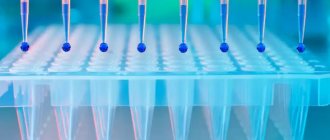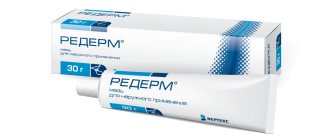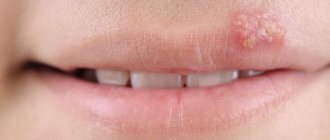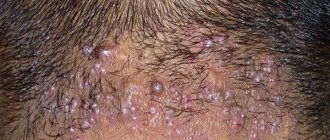Herpes simplex virus
Herpes simplex virus types I and II
Blood with EDTA is used as a biological material for this study. To prepare for the analysis, you need to stop eating food 3 hours before the procedure. You can only drink non-carbonated purified water.
Herpes simplex virus is a DNA virus. There are 2 serotypes of the pathogen - herpes simplex virus types 1 and 2.
HSV-1 often causes lesions in the mucous membranes of the mouth, eyes and skin. In rare cases, genital lesions may develop. Herpes simplex virus 1 can also cause herpes encephalitis and pneumonitis. Herpes simplex virus type 2 in most cases causes genital lesions, herpes in newborns, and disseminated herpes.
The herpes simplex virus is very dangerous during pregnancy. If the pathogen circulates in the blood, there is a high probability of spontaneous miscarriage, the development of severe damage to the fetus and baby, and the formation of congenital deformities.
In laboratory conditions, it is not difficult to detect the DNA of the herpes simplex virus in the biological material of a patient. The test can detect both types of virus.
A referral for analysis is issued in the following cases:
- The presence of characteristic symptoms of the disease (specific rashes on any part of the body);
- Aggravated obstetric history (loss of a child during childbirth, birth of a baby with serious malformations);
- Suspicion of herpes during pregnancy (those women who, during an ultrasound examination, show signs of intrauterine infection, lymphadenopathy, as well as suspected hepatitis and hepatosplenomegaly of unknown origin)
- Signs of intrauterine infection in children, as well as the presence of congenital malformations, vesicles or crusts on the skin or mucous membranes;
- Newborn infants with sepsis, hepatitis, pneumonia, eye or gastrointestinal damage;
- Comprehensive examination of patients who have an immunodeficiency state.
There is no acceptable value in interpreting test results. If DNA of the herpes simplex virus is detected in biological material, this indicates that the person is a carrier of the pathogen.
Deciphering the test for Herpes simplex virus
Antibodies to herpes simplex virus types 1 and 2
An increased concentration of specific immunoglobulins of class G indicates that the virus has definitely been present in the patient’s body for a long time. However, this analysis is never carried out once - to determine the dynamics of the development of the disease, it must be repeated 10 days after the first submission of biological material. And if by that time the concentration of viral cells in the body increases by more than 30%, this indicates that the infection is actively progressing and will soon make itself felt.
In addition, an increase in the concentration of specific class G antibodies in the blood of a pregnant woman may indicate that the fetus has an intrauterine infection. Here it is necessary to look at the patient’s condition, study the indicators of other tests, as well as the results of an ultrasound examination of the fetus. Also, if the patient had the herpes virus before pregnancy, the likelihood of developing an intrauterine infection in the fetus is significantly reduced.
If class A antibodies are detected in the blood, it is impossible to say exactly what phase the disease is currently in. But with a high degree of probability, the doctor can judge that the patient is infected.
If class M antibodies are detected, this indicates that at the time of collection of the biological material the infection was in the active phase. The production of specific immunoglobulins of this class indicates that at least 2 weeks have passed since the infection. The diagnosis depends on the concentration of these immunoglobulins - the more there are, the more aggressive the infection behaves in the body.
If the test result for herpes is negative, this indicates that the patient has not encountered this pathogen. There are a number of conditions under which a test can be false positive, but this is extremely rare.
Research method - Chemiluminescent immunoassay
Material for research - Blood serum
Herpes (Antibodies to HSV 1.2 IgG, Herpes Simplex Virus Antibody 1.2 IgG, HSV 1.2 IgG) is a viral disease characterized by a characteristic rash of grouped blisters on the skin and mucous membranes, caused by the herpes simplex virus (HSV). HSV is a DNA virus from the Herpesviridae family. There are two types of herpes simplex virus. They are characterized by various biological and epidemiological features. HSV-1 causes infections of the mucous membranes of the eyes, mouth, and nose and is one of the causes of severe sporadic encephalitis in adults. HSV-2 is characterized by anogenital lesions (so-called urogenital herpes).
The herpes simplex virus is transmitted by airborne droplets and sexually; it is also characterized by vertical transmission from a pregnant woman to the fetus. In advanced chronic cases or in cases of immunodeficiency, the herpes virus HSV-1 and HSV-2 can affect the eyes (herpetic keratitis), brain (herpetic encephalitis), and internal organs. Testing for herpes during pregnancy is simply necessary, because During pregnancy, especially in the first trimester, when the main organs and systems of the fetus are formed, primary infection of the mother can become fatal to the fetus. In this case, the risk of threatened miscarriage and miscarriages increases threefold, and the development of deformities in the fetus is possible. When infected with the herpes simplex virus in the second trimester, the risk of congenital anomalies of the fetus increases, such as congenital viral pneumonia, retinal pathology, microcephaly, and heart defects. There is a high probability of developing miscarriage. During childbirth, passing through the mother's infected genital tract, the child can become infected with herpes, especially if during pregnancy the woman experiences an exacerbation of genital herpes, and the rashes are localized on the cervix or in the genital tract.
As with all TORCH infections, during herpes infection a person produces antibodies, which significantly reduce the likelihood of disease progression and generalization of the process, and the virus most often manifests itself only when immunity is reduced (as, for example, HSV-1 during a cold). In people who are seronegative (lack of antibodies to herpes simplex viruses) and have never been infected, primary infection occurs. Secondary infection is the activation of latent infection or reinfection in seropositive patients. Most people infected with the herpes simplex virus are asymptomatic, so serological diagnosis is necessary.
IgG antibodies are formed 2–3 weeks after infection with HSV and after a few months their titer decreases significantly. In patients with relapse of the disease, the IgG antibody titer often does not increase. A final diagnosis of acute herpetic infection is possible only after isolating the virus by culture. However, serological blood testing for herpes provides valuable additional information when screening for “high-risk” groups, such as pregnant women.
Interpretation of test results is for informational purposes only, is not a diagnosis and does not replace medical advice. Reference values may differ from those indicated depending on the equipment used, the actual values will be indicated on the results form.
If a questionable result is obtained, the analysis must be repeated after one to two weeks.
A negative result in a blood test for herpes can be regarded as the absence of infection, but acute infection with HSV-1 and HSV-2 is still possible, which can occur without the development of antibodies for 2-3 weeks. If HSV infection is clinically suspected, upon receipt of a negative test result for herpes, it is necessary to repeat the test no earlier than after one to two weeks. Seroconversion from a negative result to a positive result may occur as the infection progresses. Changes in IgG antibody titer during a current herpes infection are unlikely.
Unit of measurement: Unit
Reference values:
- < 0.9 – negative result
- 0.9 – 1.1 – the result is doubtful
- ≥ 1.1 – positive result
Tests for coronavirus
- Test for coronavirus
- Coronavirus test for organizations
- Testing for coronavirus at home
- Testing for coronavirus at home in 12 hours!
- Testing for coronavirus in Lyubertsy in 12 hours!
- Testing for coronavirus in Nekrasovka in 12 hours!
- Testing for coronavirus in Korolev in 12 hours!
- Test for coronavirus on the Sokol metro station
- Coronavirus test at Kolomenskaya metro station
- Coronavirus test at Voykovskaya metro station
- Test for coronavirus in Nekrasovka
- Coronavirus test in Korolev
- Test for coronavirus in Lyubertsy
- Test for coronavirus in Mytishchi
- Test for coronavirus at home Mytishchi
- Test for coronavirus at home Korolev
- Test for coronavirus at home Lyubertsy
- Test for coronavirus at home Nekrasovka
Any tests can be taken at clinics in the East Clinic network.
Herpes Simplex Virus 1/2, IgG
This is the detection of immunoglobulins G to the herpes simplex virus of the first and second types, which are indicators of the presence of a herpes viral infection.
Synonyms Russian
Herpes virus, herpes simplex virus type 1 and 2, detection of herpes by IgG antibodies.
English synonyms
Herpes Simplex Virus, Type 1 and Type 2, HSV-1 or HSV-2 IgG, HSV-1, HSV-2, HHV1, HHV2.
Research method
Solid-phase chemiluminescent enzyme-linked immunosorbent assay (“sandwich” method).
What biomaterial can be used for research?
Venous, capillary blood.
How to properly prepare for research?
Do not smoke for 30 minutes before donating blood.
General information about the study
The most common types of viruses are the first and second ones. They are contagious and contribute to the formation of small blisters on the mucous membranes, which burst, forming open wounds. With HSV-1, the blisters appear mainly around the mouth and in the oral cavity, while HSV-2 usually affects areas around the genitals.
The herpes simplex virus can be contracted through skin contact, contact with blisters, and sometimes even in the absence of visible lesions.
HSV-2 is most often transmitted through sexual contact, however, infection with HSV-1 herpes can also occur, for example, through oral sex. According to WHO, from 50% to 80% of the adult population of developed countries are infected with herpes type 1 and about 20% with herpes type 2. Because symptoms are often subtle, 90% may not even be aware of their infection.
In the case of primary infection, painful blisters usually form at the site of infection after two weeks, which usually resolve after four weeks. They appear on the genitals, around the anus, on the buttocks or thighs, after which they can burst. You may also experience flu-like symptoms, such as chills and sore throat.
However, blisters with herpes do not always form. Sometimes symptoms of the disease are so mild that they go unnoticed or are mistaken for something else, such as insect bites or allergies. After entering the body and spreading, the herpes virus remains in a latent form. With stress or other diseases that lead to a decrease in immunity, it can become active again. In most cases, herpes simplex is not harmful to health, but it can cause serious illnesses: neonatal herpes (if a child becomes infected during childbirth from a mother infected with genital herpes) and encephalitis. They can lead to serious incurable neurological diseases and even death.
The following factors increase the risk of contracting herpes:
- diseases that suppress the immune system (for example, HIV/AIDS),
- organ transplantation.
There are antiviral drugs that suppress the spread of herpes, and also shorten the duration of the acute phase of the viral infection and alleviate the symptoms of the disease.
Antibodies are produced to fight infection. The formation of IgG to the herpes simplex virus begins a few days after the appearance of IgM. The concentration of IgG in the blood initially increases for several weeks, then falls, and then stabilizes. When re-infected with herpes, it increases much faster - already in the first days of infection. After an illness, small amounts of IgG remain in a person until the end of life, which, however, does not provide one hundred percent protection against re-infection.
What is the research used for?
- As an auxiliary study to confirm the diagnosis for symptoms of herpetic lesions (ulcers, blisters on the mucous membranes) or neonatal herpes.
- To screen certain groups of people, such as those who are sexually active, potential recipients infected with the AIDS virus, or those who have previously been exposed to HSV infection.
When is the study scheduled?
- When examining persons who have been in contact with HSV patients.
- During preparation for pregnancy and when monitoring it.
What do the results mean?
Reference values
S/CO ratio (signal/cutoff): 0 - 0.9.
A positive result means the presence of IgG antibodies to HSV-1 or HSV-2, indicating either an active or past herpes virus infection.
A negative result indicates a low probability of acute herpes viral infection, and also indicates that the body has not previously been in contact with the herpes simplex virus. However, immediately after infection, when sufficient antibodies have not yet been developed, the result may be false negative. In this case, an additional IgM test and a repeat IgG test after a few weeks are recommended.
What can influence the result?
The following can reduce the concentration of antibodies:
- antiviral therapy,
- immunodeficiency.
Important Notes
- Herpes is most dangerous for newborns and for patients with weakened immune systems.
- Herpes increases the risk of contracting HIV infection and can make HIV-infected patients even more infectious by increasing the amount of immunodeficiency virus in their blood.
Also recommended
- Herpes Simplex Virus 1/2, IgM
- Herpes Simplex Virus 1/2, DNA [real-time PCR]
- Herpes Simplex Virus 1/2, DNA [real-time PCR]
- Herpes Simplex Virus 1/2, immunofluorescence
- Human Papillomavirus of high carcinogenic risk (types 16, 18, 31, 33, 35, 39, 45, 51, 52, 56, 58, 59), DNA genotyping [real-time PCR]
Who orders the study?
Dermatologist, infectious disease specialist, gynecologist, urologist, pediatrician.
IgG antibodies to HSV type 1 (determination of blood levels)
What is it for
The analysis allows you to determine infection with herpes simplex virus type 1 and assess the presence of immunity in the body to the virus.
In the population, Ig G class antibodies to herpes simplex viruses are detected in 90-97% of the adult population, including 90-95% of women of reproductive age.
There are two types of herpes simplex virus. HSV1 (HSV1)
It is transmitted mainly through oral contact, and causes oral herpes (symptoms of which can manifest as “cold sores”), but can also be transmitted orally-genitally, causing lesions in the anogenital localization.
HSV2 (HSV2)
is transmitted primarily through sexual contact, mainly causing the clinical manifestations of genital herpes.
Parenteral and transplacental routes of infection are also possible.
Primary infection caused by HSV poses a particular danger during pregnancy due to the high risk of spontaneous miscarriage and the development of severe damage to the fetus and newborn.
Determination of IgG antibodies to HSV is recommended when planning pregnancy, in the presence of specific clinical manifestations, etc.
IgG antibodies to HSV are included in the TORCH complex
, which includes the determination of IgG and IgM antibodies for infections considered dangerous for the development of the child and the course of pregnancy. Therefore, before or in the early stages of pregnancy, a comprehensive determination of antibodies to infections is desirable.
In the case of primary infection with herpes viruses, successive reactions are launched within 14–28 days, inducing the formation of specific immunity. B lymphocytes first produce IgM with little specificity and a large contact surface. At the beginning of the primary infection, highly specific low-avidity (loosely binding to the antigen) IgG is detected, and later more advanced high-avidity, highly specific IgG is produced. Next, memory B cells are formed, which, upon repeated contact with the antigen, are able to activate other clones in a short time to produce IgG. IgM and low-avidity IgG during primary infection are detected from 4-6 days from the onset of clinical manifestations to 2 months with a peak at the 2nd week. High-avidity IgG appears from 10-14 days, their concentration increases, reaching a maximum at 4-6 weeks of primary infection, then high-avidity IgG is detected in lower titers for many years. Low-avidity IgG can only be detected during primary infection. Relapse is not always accompanied by the appearance of antiviral IgM and an increase in IgG titers.
In accordance with the Draft Clinical Guidelines for the Diagnosis, Treatment and Prevention of Congenital Infection Caused by Herpes Simplex Viruses, a laboratory marker of primary herpes infection in a pregnant woman
is the detection in the blood serum of specific antibodies of the IgM class in an amount 2 or more times higher than the immune sensitivity threshold of the method in two studies performed with an interval of 14 days in the same laboratory using the same method (enzyme-linked immunosorbent assay (ELISA), chemiluminescent immunoassay (CLIA)) provided that specific IgG is detected in the second study, exceeding the sensitivity threshold of the method with an avidity below 40%.
Laboratory marker of reactivation of latent HSV infection in a pregnant woman
is at least a single detection in the blood serum of specific antibodies of the IgM class in an amount 2 or more times higher than the sensitivity threshold of the method (ELISA, CLIA), or an increase in the value of specific IgG with high avidity (more than 50%) 4 or more times during 4 weeks.
Treatment
The following areas of treatment are currently used:
- blocking the reproduction of herpesvirus;
- symptomatic treatment to improve general well-being
- correction of the immune system.
To effectively treat the infection, antiviral drugs are used acutely and during periods of reactivation, along with symptomatic treatment. The treatment course includes virostatic drugs and interferons. When a patient has severe symptoms of infection, intravenous immunoglobulins are used to treat them.
Symptoms
The content of the article
HSV-2 infection is manifested by redness of the skin and itching. The virus affects the skin and mucous membranes of the genital organs. In particular, in women it affects the vaginal area, and in men it affects the urethra, scrotum and penis itself.
Symptoms of inflammation often appear on the inner surface of the buttocks and thighs, as well as around the anus. After two days, papules form at the site of inflammation - a characteristic rash in the form of nodules. They quite quickly enter the maturation phase - into vesicles filled with clear serous fluid. These rashes appear as large clusters consisting of groups of tiny blisters.
At the same time, the person’s skin itches and hurts. Within 2-3 days, most of the blisters crack, and in their place ulcers form, which are then covered with a dry crust. The patient's condition improves only after 2-3 weeks; during this period, incomplete clinical recovery is observed.
HSV-2 can cause the following symptoms: general weakness and malaise, as well as low-grade fever. In men and women with herpes virus type 2, the inguinal lymph nodes often become enlarged. The time of relative health (remission) alternates with periods of exacerbation of herpes.
Detailed description of the study
Herpes simplex virus is a common viral infection caused by the herpes simplex virus (HSV). Most often it occurs in a hidden - latent, asymptomatic - form. The appearance of clinical signs of herpes infection in humans is always associated with a weakening of the body’s immune system, and the stronger the immune disorders, the more severe the disease.
In total, there are about two hundred varieties of the virus, but only 8 of them affect humans. Each type has its own characteristics. Herpes simplex viruses of the first (HSV-1 / HSV-1) and second (HSV-2 / HSV-2) types are the most studied. HSV-1 typically affects the lips, facial skin, and oral mucosa. HSV-2 - genitals.
Infection with herpes simplex virus type 1 in the vast majority of people occurs in early childhood, after the infant has lost the passive immunity received from the mother. The main route of transmission of herpes virus type 1 is contact or household contact. The virus is transmitted through saliva through poorly washed hands and shared objects.
Infection with herpes simplex virus type 2 mainly occurs through sexual contact with an infected partner. Cases of transmission of infection during childbirth have also been described, when a newborn, passing through the birth canal, comes into contact with vaginal secretions containing the virus.
Acute infection after infection may be asymptomatic or have some clinical manifestations.
Characteristic clinical manifestations of the acute form include the formation of small transparent bubbles (vesicles) on the mucous membranes of the mouth or face (HSV-1) or in the genital area (HSV-2). At the site of vesicle formation, a person feels itching and burning.
After the initial infection, the herpes simplex virus remains in the cells of the central nervous system, where its reproduction is restrained by the immune system, but when the immune system is weakened, the virus enters the blood again (relapse, reactivation). As a rule, relapse of infection occurs due to immunodeficiency due to:
- Prolonged exposure to the sun;
- Stress;
- Long-term use of glucocorticosteroid medications;
- Decreased immunity;
- HIV infections.
To diagnose a herpes virus infection, the patient is examined, and laboratory confirmation is also used, which can be carried out using classical laboratory diagnostic methods - the presence of the virus is determined in samples of biomaterial obtained from vesicles. Serological research methods are also used, which detect specific antibodies in the blood serum. Determining the stage of herpes infection is possible by classes of specific antibodies - IgM and IgG.
IgM is produced immediately after infection and serves as a marker of the acute period of the disease, IgG begins to be produced approximately 2-4 weeks after infection and can remain in the blood for many months, indicating the chronic stage of infection.
This study allows us to identify reactivation of the infection, determine the type of virus that caused the disease, and also confirm the preliminary diagnosis (herpes virus infection).
Prevention
The best way to protect yourself from relapses of HSV-2 is to maintain the protective functions of the human body and strengthen the immune system as a whole. A healthy, normal lifestyle, proper and nutritious nutrition, as well as giving up various addictions and reducing stress help prevent recurrent manifestations of this virus.
During periods of remission, restoration of microflora in the intestinal cavity and treatment of other inflammatory diseases should be carried out. Patients are advised to use immunostimulants that are based on natural substances and components. At this stage, vaccination is possible to form the protective functions of the immune system.
The vaccine is effective in the treatment of herpes type 2. It helps reduce the likelihood of relapse and better tolerate further possible complications. After vaccination in the remission phase, patients undergo regular clinical examinations. At this stage, it is very important to give the body a rest and prepare it for the next treatment.
Monitoring the progress of remission is recommended every 3 months, and in the absence of relapses - once a year. Such measures are necessary, especially for women planning pregnancy or during pregnancy. For some groups of patients, further treatment with immunomodulatory drugs and probiotics is possible. With proper and appropriate treatment, the prognosis for most patients is favorable.
Exacerbation of the disease
The first symptoms of herpes type 2 are pronounced. Then the pain, the frequency of damage to the skin and mucous membranes, as well as the duration of the inflammation itself with subsequent exacerbations decrease. In this case, in men and women, blisters and scabs do not appear, and the residual manifestation is preceded by burning and tingling in the genital area. In some cases, HSV-2 may be accompanied by slight genital discharge and difficulty urinating.
Some women and men recover from HSV-2 with few symptoms. The activity and external manifestations of herpes infection depend on the state of the immune system. Some patients may experience several phases of deterioration throughout their lives, while others struggle with it every six months. It all depends on the weakening of the body’s defenses.
As this disease progresses, patients may develop general intoxication, as well as loss of strength, decreased activity, depression, decreased performance and appetite.
Possible complications
HSV-2 infection poses a threat to the reproductive functions of women and men. In pregnant women, a primary infection or recurrence of the disease can lead to miscarriage. Like other herpes, HSV-2 can cause birth defects or death in the womb.
Most often, infection of a child in the womb is provoked by active infection with HSV-2 without clear clinical symptoms. When observed in women, frequent and prolonged relapses of genital herpes significantly increase the risk of developing cervical cancer, and in men - prostate paralysis.









